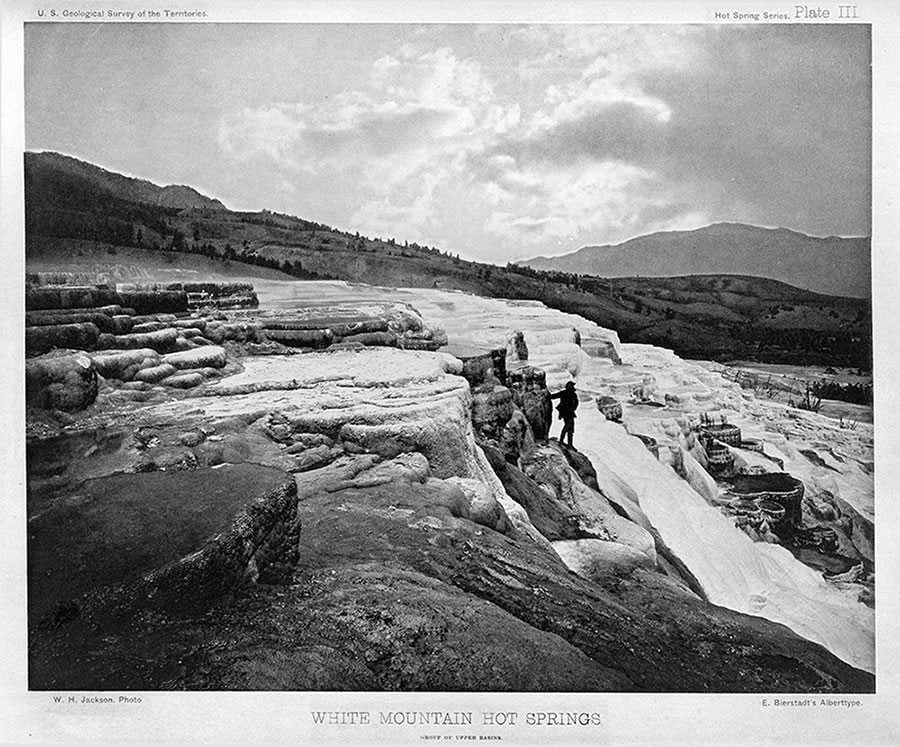The Buffalo Bill Center of the West announces the discovery of an extremely rare collection of Albertype photographs from the 1871 U.S. Geological Survey of Yellowstone National Park. Collector Dr. Robert Enteen has loaned an album of the images to the Center’s McCracken Research Library in honor of the National Park Service’s (NPS) 100th Anniversary in 2016.
Starting March 21, the Center exhibits Yellowstone Discovered, a selection of the Albertypes through digital reproduction in the John Bunker Sands Gallery. A formal opening takes place June 1, and the exhibit closes August 14. It is one of several programs celebrating the NPS Centennial at the Center this year.

At the request of the United States government, geologist Ferdinand Vandeveer Hayden led several expeditions in the West following the Civil War. Photographer William Henry Jackson accompanied the Hayden surveys to explore and document the region that includes present-day northwest Wyoming. It was the survey of 1871 that produced Jackson’s photographs of the spectacular landscapes and geologic wonders of the area now known as Yellowstone, and ultimately led to the establishment of America’s first national park.
Jackson returned from the West with a marvelous set of glass plate negatives and produced a limited number of albums of beautiful, mounted photographs. The Center’s McCracken Research Library has an example of one of these rare albums. At that time, however, there was no established method to publish photographs of such high quality to the general public. Albertypes, prints produced from a gelatin-coated glass plate, seemed to offer the answer. The technique was complex and expensive, but the result was a finely detailed image with subtle gray tones.
Edward Bierstadt, brother of noted western artist Albert Bierstadt, created superb Albertypes (named for one J. Albert of Munich in 1868) in his New York studio using Jackson’s original negatives. By this method the prints were capable of mass-production to Americans, and in Hayden’s plan, would promote the park’s unique attractions. A publishing project in several volumes was in the works when, disastrously, a fire at the Bierstadt studio in 1875 destroyed the Jackson/Bierstadt Albertypes, along with Jackson’s glass plate negatives and contact prints.

As a result, the planned survey volume that focused on Yellowstone was never published. The surviving Albertypes were lost to history, with the exception of only a very few known sets of proofs. Though promoting Yellowstone and the national parks would create a wealth of imagery, these beautiful photographic prints intended to astonish and delight the public were largely lost from view. The newly discovered album of 76 Albertypes is the most complete ever found. The collection represents a comprehensive travel narrative of the groundbreaking 1871 exploration.
According to Dr. Matthew Hermes, Research Associate Professor in the Department of Bioengineering at Clemson University in South Carolina, “The Jackson Albertypes, had they been used as originally intended, would have been the first effort to promote Yellowstone by photographs. We like to think they would have been broadly popular, the first ‘coffee table’ book perhaps.”
A resident of the San Francisco Bay area, Enteen is a collector of rare, early photographs. When he discovered the Albertype collection and realized its historical significance, he contacted Hermes who introduced him to Mary Robinson, Housel Director of the Center’s McCracken Research Library. She shared with Enteen the Center’s efforts in 2016 to commemorate the centennial of the founding of the U.S. National Park Service. As a result, he offered to lend the album to the Center. “This is such an extraordinary group of images that Dr. Enteen has loaned us,” Robinson observes, “and how fortuitous that Dr. Enteen and Dr. Hermes brought it to our attention. We are excited to share it with our visitors.”
Enteen has been researching and collecting photographs dating from the field’s earliest beginnings in Europe in 1839. He’s amassed a large collection including works by Henry Fox-Talbot, Felix Nadar, Fratelli Alinari, Adolphe Braun, and many others, from France, England, Italy, and Germany. The Jackson Albertypes represent the most significant American works in his collection.
“Finding this rare and historically significant collection of Albertypes was enormously exciting for me,” Enteen explains, “and I am especially gratified by the eagerness of the staff at the Center of the West to feature them as part of the centennial celebrations. I am also grateful to Dr. Hermes, a national authority on the history of Yellowstone, and the scholars at the Center, for authenticating the photographs and verifying the fact that they are the only complete set known to exist.”
Additional information: What is an Albertype?
Since 1917, the award-winning Buffalo Bill Center of the West in Cody, Wyoming, has devoted itself to sharing the story of the authentic American West. The Center is an affiliate of the Smithsonian Institution. For additional information, visit centerofthewest.org or the Center’s Facebook page.





